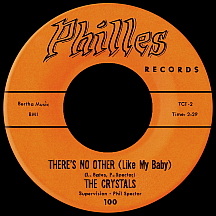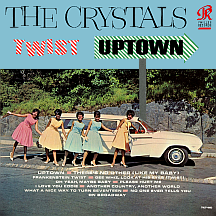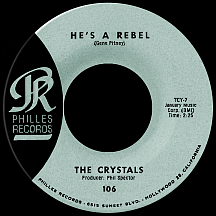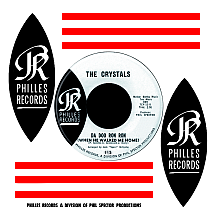THE CRYSTALS
In 1961, former Teddy Bear Phil Spector was working for Liberty Records' Artists and Repertoire department while bouncing back and forth between Los Angeles (where Liberty was headquartered) and New York (where he'd recently worked for Atlantic Records). Phil stayed busy producing singles for outside labels, scoring hits that summer and fall ("Pretty Little Angel Eyes" by Curtis Lee, "Every Breath I Take" by Gene Pitney) while developing a swagger; confident that he would mastermind many hits in the months and years to come, this egotism was well-founded because he did just that. After forming an independent label with Lester Sill, he immediately scored a hit by a female quintet from Brooklyn, Philles Records' first hitmakers: The Crystals.
L.A.-born Sill had been in the music business several years, a partnership with Jerry Leiber and Mike Stoller at their short-lived Spark Record label (1954 through '56) among his accomplishments. His partnership with Spector five years later had him running the business end so Spector would be free to indulge his preference: producing records. They set up a publishing company with BMI, calling it Bertha or Mother Bertha (after Phil's mom), and Philles came from a combination of their own names. Harold Lipsius of Jamie Records became a silent third partner. Helen Noga (Johnny Mathis's manager) agreed to help finance the recording sessions.
The Crystals were students at Central Commercial High School on East 42nd Street in New York. Original lead vocalist Barbara Alston joined her friends Mary Thomas, Myrna Gerrard, Patricia Wright and Dee Dee Kenniebrew, all of whom provided backing vocals, harmonies and occasional leads. Family connections were strong; Barbara's uncle, Benny Wells, became their manager, Patricia's brother-in-law, Leroy Bates, wrote songs for them and they named the group after Leroy's baby daughter, Crystal. Of the many New York labels they auditioned for, Johnny Bienstock of Big Top Records showed the most interest and put them to work recording demonstration discs for the company's publisher, Hill and Range. At one point they auditioned for Spector with one of Bates' songs, a midtempo number called "There's No Other (Like My Baby)." Phil asked them to slow the tempo and liked the result; with Big Top undecided, he signed the group and began making plans for a recording session.
He had accepted an offer from Snuff Garrett to take an A&R position at Liberty Records (replacing the departing Clyde Otis), but once Philles was established, he focused more on his own productions and less on the interests of Liberty, biding his time in case the Crystals song wasn't a hit (though his ego told him it would be). The group's first tracks came to life at Mira Sound Studios in the heart of Manhattan. Going against the common practice of recording in stereo (particulary in the bigger studios), these efforts were in mono, which Phil preferred and recorded in almost exclusively for as long as the Philles label was in business. "There's No Other" (a relatively simple production reminiscent of late '50s doo wop and early recordings by girl groups like The Chantels and The Shirelles) was backed with "Oh Yeah, Maybe Baby" (Patricia on lead vocal) and released in October. At first the disc was overshadowed by the success of The Paris Sisters' "I Love How You Love Me," a top ten hit in November and December that Phil had produced that summer for the Gregmark label owned by Sill and Lee Hazlewood. Phil even headed to L.A. late in the year to produce a follow-up Paris Sisters single, "He Knows I Love Him Too Much."
"There's No Other" reached the national pop chart more than a month after its release, then began a gradual climb, peaking in the top 20 the first week of January 1962. Phil remained in New York during this time, producing outside artists including Big Top acts Arlene Smith (who'd left the Chantels to attempt a solo career) and Sammy Turner, plus two singles for Dune Records that had minor chart success: Lee's "Pretty Little" follow-up "Under the Moon of Love" and a typically emotional Ray Peterson song, "I Could Have Loved You So Well." All the while he kept an eye on the progress of his label's debut single. Myrna Gerard had gotten married some months earlier and with a child on the way, she decided to leave the group. 15-year-old Dolores Brooks, nicknamed "La La" to prevent confusion with Dee Dee, was hired. Six Crystals were at the recording session for "Uptown" prior to Myrna's exit. The song, penned by Barry Mann and Cynthia Weil, was a step forward from the first production, featuring a full string section, Spanish guitar...and castanets! It spent several weeks in the top 20 in May and June of '63.
Carole King and Gerry Goffin wrote "He Hit Me (And it Felt Like a Kiss)" after their live-in nanny Little Eva (who'd graduated to chart-topping hitmaker status the previous summer with "The Loco-Motion") told them she loved her boyfriend despite the fact he sometimes struck her. Spector produced the song with the Crystals in a minor key, laying on strings for emotional effect. The single received airplay at far-flung radio stations that summer, mainly on the east and west coasts, but complaints about its subject matter made it a very hard sell. Goffin and King were in a dark place as songwriters and Spector liked what they offered him; they wrote two other songs for the Crystals with a similar tone and message: "No One Ever Tells You" (the flip side of "He Hit Me") and "Please Hurt Me," included on their album Twist Uptown. Having done sessions at Hollywood's Gold Star Studios early in his career and more recently getting strong results there with the Paris Sisters, Phil decided it was where he wanted to create all of his Philles masters. One advantage: he ended up working with arranger Jack Nitzsche who, unlike many ohers, understood what Phil was striving for...most of the time, anyway.
Gene Pitney was so impressed with "Uptown" that he set to work writing a song with the Crystals in mind. The dynamic lyrics of "He's a Rebel" struck a chord with Spector, possibly because it reminded him of himself ('...he holds his head up high when he goes walking by, he's my guy...he's not just one of the crowd...my baby's always the one, to try the things they've never done...'). As soon as he heard Gene's demo of the song, he prioritized getting the record out with his star act. Phil had quit his job at Liberty Records a few months earlier; could he have known Snuff Garrett was planning to produce the song for Liberty with relative newcomer Vikki Carr? He claimed to have found out about it after the fact. At any rate, a problem presented itself: the Crystals were touring and unavailable on short notice, so with Sill's help he hired The Blossoms, a female trio that, among other things, had recently done vocals for Duane Eddy's "(Dance With The) Guitar Man" as The Rebelettes (the name strictly a coincidence). Group members Fanita James, Gloria Jones and booming lead vocalist Darlene Wright had been doing sessions in the L.A. area for several years and had a handful of singles released by Capitol, Challenge and Okeh Records. They were in high demand and Spector paid them well to drop whatever they were doing and record the song. He also hired Bobby Sheen, a male vocalist he'd made a record with at Liberty, for background vocals.
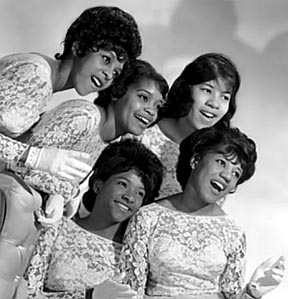
Phil released "He's a Rebel" under the Crystals' name, which he owned the rights to, knowing he would have an easier time promoting a record by an established act. The single hit number one nationally in November, crushing Vikki's version. Darlene, who'd delivered a whopper of a vocal, didn't expect anything to come of it, but Phil was impressed and just a few weeks later she was back in the studio with Fanita and Bobby to do the vocals on a remake of "Zip-A-Dee Doo-Dah," an Oscar-winning song from the 1947 Walt Disney film Song of the South. This unlikely choice became a top ten hit by year's end under the name Bob B. Soxx and the Blue Jeans, which the singers didn't know about until after its release. Darlene sang lead on other tracks at Gold Star; the fast-paced, celebratory "He's Sure the Boy I Love" came out as a Crystals follow-up and made its way to the top 20 by February '63. The Crystals themselves were not pleased with this turn of events that forced them to perform hit songs they couldn't match vocally. Newer member La La Brooks had the closest delivery to Darlene's and took the lead on these songs in concert, a blow to Barbara Alston's ego. Back in L.A., Darlene had her own issues with not getting credit for the hits.
Spector didn't care. His success was his and his alone...or so he figured. He wanted Lester Sill out of the picture and Sill was fine with leaving, though prying the measly 60 thousand bucks they'd agreed on out of Spector was more trouble than it was worth. Phil had a little fun with the situation (his idea of fun, perhaps not mine or yours or Sill's), making his point in a spectacularly rude and crude way: by recording the Crystals (the original group, back in the studio) with former Teddy Bears pianist Michael Spencer, on "(Let's Dance) The Screw" in two parts, each repetitious side running close to six minutes. Sung: 'Let's do it, to the right, to the left...' Spoken (with a deadpan delivery by by Spector's lawyer): 'Dance the screw.' One big gag, right? He had a copy delivered to Sill and a few other 45s were pressed. It's arguably the worst record Phil ever made. Also the rarest and most collectible record he ever had pressed.
Back to serious business: "Da Doo Ron Ron (When He Walked Me Home)." N.Y.-based songwriters Jeff Barry and Ellie Greenwich came up with a catchy "nonsense" title for an otherwise heartfelt romantic song. Phil recorded it with Darlene Love (a name he'd given Ms. Wright, who finally got a couple of top 40 hits that year under her new stage name), but for this track he preferred the youthful exuberance of La La Brooks. The version by the "real" Crystals, with La La's lead, got as high as number three on the charts in June 1963. The "Wall of Sound" (as it has commonly become known), achieved with massive numbers of studio musicians, overdubbing, echo and needle-peaking volume levels, was reaching full impact. "Da Doo Ron Ron" did so well that Phil had Brooks take the lead on the next single, a similar teen-rom tune, "Then He Kissed Me," a top ten hit at the end of summer.
As studio sessions continued, Spector showed preference for La La (but not necessarily the other Crystals), Darlene, Fanita, Bobby Sheen and a number of other artists including The Ronettes, a trio from New York that would soon have a major hit of their own ("Be My Baby"). In the fall, he focused on recording A Christmas Gift for You from Phil Spector, 13 songs with Wall of Sound-style renditions of seasonal standards (and one original, "Christmas (Baby Please Come Home)," sung by Darlene); the Crystals' contributions were "Santa Claus is Coming to Town," "Rudolph the Red-Nosed Reindeer" and "Parade of the Wooden Soldiers." It was released on November 22, the same day President John F. Kennedy was assassinated. That gloomiest of holiday seasons could have been the reason the album wasn't well-received, a notion that sent Spector into a depressed state; he was certain it would be a big success and took its failure way too personal. Of course, the album's irresistible tracks found an audience through radio play years later and is now considered a classic (that exact cycle played out at least one other time with a certain recording he produced for Ike and Tina Turner: "River Deep - Mountain High").
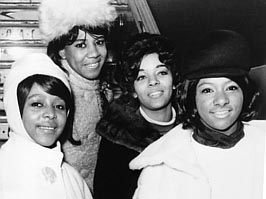
Though Spector still had an apartment in New York (where his recently-wed wife, Annette Merar Spector, lived...with him...sometimes), he'd been spending longer stretches in Los Angeles because of his preference for the sound he got at Gold Star. By early 1964, dissent in the ranks of the Crystals had become a problem for everyone but him. Mary Thomas, disillusioned by the use of other singers on Crystals records, quit the group. Barbara Alston left a few months later for similar reasons. Phil didn't care and even brushed off Darlene Love; he had moved on to his new girls. Dee Dee Kennibrew stayed with Brooks as the two remaining Crystals; Frances Collins joined at some point and they moved forward as a trio, touring extensively in 1964 including a summer stint with Dick Clark's Caravan of Stars, sharing the bill with girl group competitors the Shirelles, The Dixie Cups and Motown's suddenly-hot Supremes. "Little Boy" was issued as their eighth single (not counting "The Screw"), but Spector was much more interested in the Ronettes, professionally and, in lead singer Veronica Bennett's case, personally. The Crystals suffered as a result, not to mention Phil's soon-to-be ex-wife.
"All Grown Up," the final Crystals release on Philles in the summer of '64, had been recorded with the group more than a year earlier during the same sessions as "Then He Kissed Me." The group's last two singles (Barry-Greenwich compositions with some level of input from Spector, who shared writer credit) barely reached the bottom rungs of the charts. Even the Ronettes discs Spector released during 1964 couldn't compete with other girl groups (Martha and the Vandellas, The Shangri-Las and the Crystals' abovementioned tourmates). Mary Thomas and Myrna Gerrard joined another group, The Butterflys (with Carmen Santiago and lead singer Paulette Holland, both from their home town of Brooklyn), and made two Barry-Greenwich-penned singles in '64 for Leiber and Stoller's Red Bird Records, "Good Night Baby" and "I Wonder," the latter previously recorded by both the Crystals and Ronettes.
In 1965, the Crystals (La La, Dee Dee and Frances) signed with United Artists Records, under the direction of producer Paul Tannen and prolific arranger Charlie Calello (best-known for a string of 4 Seasons hits). "My Place" had the dance-club soul sound of the mid-'60s, as did its follow-up, "Are You Trying to Get Rid of Me Baby," a Nick Ashford-Valerie Simpson-Jo Armstead song arranged by Trade Martin and credited to The Crystals (featuring La La Brooks). Neither made much noise. In 1967, Dee Dee reunited with Barbara and Mary for one final Crystals single, "Ring-A-Ting-A-Ling" on the Baton Rouge-based Michelle label. Phil Spector was no longer a factor, existing only as a distant memory. Most of the group's members chose to give up the struggle and live "normal" lives. In the early 1970s, Dee Dee Kenniebrew and La La Brooks began performing in concert with backing singers and, as The Crystals, continued off and on for many years.
NOTABLE SINGLES:
- There's No Other (Like My Baby) /
Oh Yeah, Maybe Baby - 1961 - Uptown /
What a Nice Way to Turn Seventeen - 1962 - He Hit Me (And it Felt Like a Kiss) /
No One Ever Tells You - 1962 - He's a Rebel /
I Love You Eddie - 1962 - He's Sure the Boy I Love - 1963
- (Let's Dance) The Screw - Part I /
(Let's Dance) The Screw - Part II - 1963 - Da Doo Ron Ron (When He Walked Me Home) - 1963
- Then He Kissed Me - 1963
- Little Boy - 1964
- All Grown Up - 1964
- My Place - 1965
- Are You Trying to Get Rid of Me Baby - 1966
as the Crystals (featuring La La Brooks) - Ring-A-Ting-A-Ling - 1967


